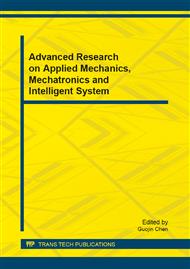p.129
p.132
p.139
p.145
p.149
p.153
p.159
p.164
p.170
Redundant Driving Underactuated Robot Finger for Powerful Grasp
Abstract:
In tradition, one underactuated robotic finger with two or three joints always utilizes only one actuator for self-adaptive grasp, which results in quite weak grasping force because there is only one motor and the motor is so small in size so that it can be embedded into the phalange of the robot finger or the palm of the robot hand. Aiming to overcome the weakness, this paper proposed a novel robotic finger with redundant driving, called RD finger, which can produce sufficient grasping force through increasing a redundant motor and keep original characteristic of self-adaptive grasp. A special single direction transmission mechanism is designed in the finger to make two motors seem like one motor and prevent interference between the first motor and the second motor. The grasping process of the RD finger is close to traditional underactuated finger but there is up to double grasping force. One kind of the RD finger is designed in detail with coupling and self-adaptive grasping mode, which is composed of two motors, bevel gears, a pulley-belt transmission, a single direction transmission and a spring. In addition, the RD finger is compact, easy to control, low in energy consumption, is able to provide wide range of grasping force, and is therefore suitable for humanoid hands.
Info:
Periodical:
Pages:
149-152
Citation:
Online since:
July 2013
Authors:
Price:
Сopyright:
© 2013 Trans Tech Publications Ltd. All Rights Reserved
Share:
Citation:


